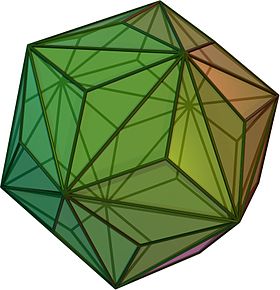Triakis icosahedron
| Triakis icosahedron | |
|---|---|
 (Click here for rotating model) | |
| Type | Catalan solid |
| Coxeter diagram | |
| Conway notation | kI |
Face type |
V3.10.10 isosceles triangle |
| Faces | 60 |
| Edges | 90 |
| Vertices | 32 |
| Vertices by type | 20{3}+12{10} |
| Symmetry group | Ih, H3, [5,3], (*532) |
| Rotation group | I, [5,3]+, (532) |
| Dihedral angle | 160°36′45″ arccos(−24 + 15√5/61) |
| Properties | convex, face-transitive
|
 Truncated dodecahedron (dual polyhedron) |
 Net |
In geometry, the triakis icosahedron is an Archimedean dual solid, or a Catalan solid, with 60 isosceles triangle faces. Its dual is the truncated dodecahedron. It has also been called the kisicosahedron.[1] It was first depicted, in a non-convex form with equilateral triangle faces, by Leonardo da Vinci in Luca Pacioli's Divina proportione, where it was named the icosahedron elevatum.[2] The capsid of the Hepatitis A virus has the shape of a triakis icosahedron.[3]
As a Kleetope
The triakis icosahedron can be formed by gluing triangular pyramids to each face of a
When depicted in Leonardo's form, with equilateral triangle faces, it is an example of a non-convex deltahedron, one of the few known deltahedra that are isohedral (meaning that all faces are symmetric to each other).[4] In another of the non-convex forms of the triakis icosahedron, the three triangles adjacent to each pyramid are coplanar, and can be thought of as instead forming the visible parts of a convex hexagon, in a self-intersecting polyhedron with 20 hexagonal faces that has been called the small triambic icosahedron.[5] Alternatively, for the same form of the triakis icosahedron, the triples of coplanar isosceles triangles form the faces of the first stellation of the icosahedron.[6] Yet another non-convex form, with golden isosceles triangle faces, forms the outer shell of the great stellated dodecahedron, a Kepler–Poinsot polyhedron with twelve pentagram faces.[7]
Each edge of the triakis icosahedron has endpoints of total degree at least 13. By Kotzig's theorem, this is the most possible for any polyhedron. The same total degree is obtained from the Kleetope of any polyhedron with minimum degree five, but the triakis icosahedron is the simplest example of this construction.[8] Although this Kleetope has isosceles triangle faces, iterating the Kleetope construction on it produces convex polyhedra with triangular faces that cannot all be isosceles.[9]
As a Catalan solid


The triakis icosahedron is a
Let denote the golden ratio. The short edges of this form of the triakis icosahedron have length
and the long edges have length
Its faces are isosceles triangles with one obtuse angle of
and two acute angles of
As a Catalan solid, its dihedral angles are all equal, 160°36'45.188". One possible set of 32 Cartesian coordinates for the vertices of the triakis icosahedron centered at the origin (scaled differently than the one above) can be generated by combining the vertices of two appropriately scaled Platonic solids, the regular icosahedron and a regular dodecahedron:[12]
- Twelve vertices of a regular icosahedron, scaled to have a unit circumradius, with the coordinates
- Twenty vertices of a regular dodecahedron, scaled to have circumradius with the coordinatesand
Symmetry
In any of its standard convex or non-convex forms, the triakis icosahedron has the same symmetries as a regular icosahedron.[4] The three types of
See also
- Triakis triangular tilingfor other "triakis" polyhedral forms.
- Great triakis icosahedron
References
- ^ ISBN 978-1-56881-220-5.
- ^ .
- PMC 4312766.
- ^ .
- Zbl 1185.52009.
- ISBN 0-521-66405-5.
- ISBN 0-521-09859-9.
- MR 0720304.
- .
- ^ Weisstein, Eric W. "Triakis icosahedron". MathWorld.
- ISBN 0-486-23729-X.
- .



























































